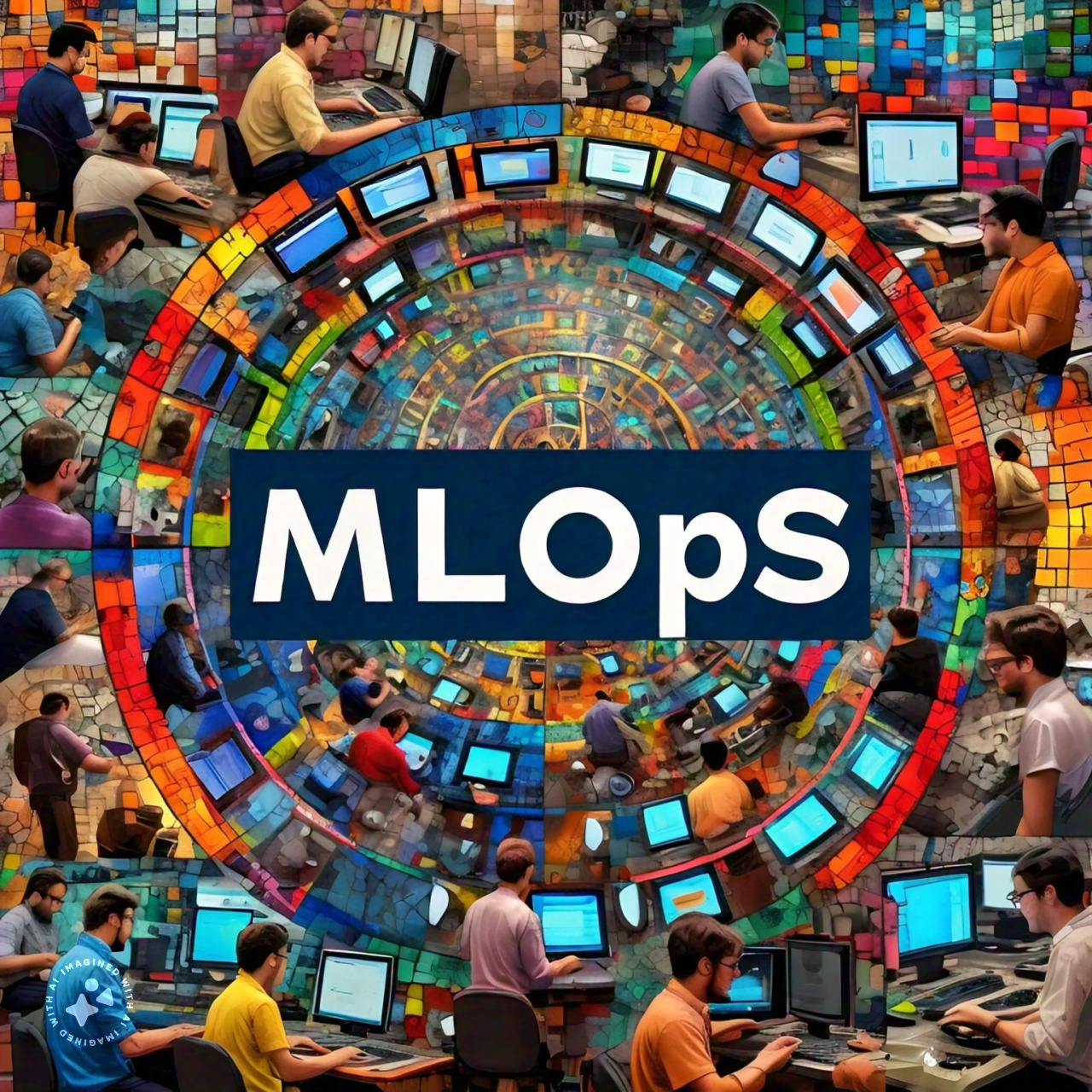
MLOps or Machine Learning Operations! Imagine pouring hours of meticulous work into crafting a groundbreaking machine learning model,
only to see its performance plummet once deployed in the real world. Frustrating, right? This scenario, unfortunately,
plays out far too often in the realm of machine learning, where the gap between development and production poses a significant bottleneck to innovation.
This is where MLOps, or Machine Learning Operations, steps in as the missing puzzle piece.
MLOps is the glue that seamlessly binds the worlds of data science and software engineering, ensuring a smooth transition of
machine learning models from the controlled environment of development to the ever-evolving landscape of production.
Have you ever wondered why some seemingly groundbreaking machine learning models fail to deliver their promised results in real-world applications?
The answer often lies in the disconnect between the data science teams who meticulously build these models and
the engineering teams responsible for their deployment and ongoing maintenance. This siloed approach, coupled with a lack of automation and monitoring, can lead to a plethora of challenges:
- Siloed Data Science and Engineering Teams:
Data scientists and engineers often operate in separate spheres, leading to communication gaps and inefficiencies in the ML workflow.
- Lack of Automation and Monitoring:
Manually managing the training, deployment, and monitoring of ML models is prone to errors and inconsistencies, hindering optimal performance.
- Difficulty in Model Reproducibility and Explainability:
Complex models can be challenging to reproduce and explain, raising concerns about transparency and potential biases.
- Inefficient Model Deployment and Updates:
The traditional approach to deploying and updating models can be slow and cumbersome, hindering the ability to adapt to changing conditions.
+---------------+
| Data Ingest |
+---------------+
|
|
v
+---------------+
| Data Prep |
| (e.g. Pandas) |
+---------------+
|
|
v
+---------------+
| Model Training|
| (e.g. scikit- |
| learn, TensorFlow)|
+---------------+
|
|
v
+---------------+
| Model Deployment|
| (e.g. Docker, |
| Kubernetes) |
+---------------+
|
|
v
+---------------+
| Model Serving |
| (e.g. TensorFlow|
| Serving) |
+---------------+
|
|
v
+---------------+
| Monitoring |
| (e.g. Prometheus,|
| Grafana) |
+---------------+
|
|
v
+---------------+
| Feedback Loop |
| (e.g. Jupyter |
| Notebook) |
+---------------+
Here's a brief description of each stage:
- Data Ingest: Collecting and processing data from various sources.
- Data Prep: Preparing and transforming data for model training.
- Model Training: Training machine learning models using various algorithms and frameworks.
- Model Deployment: Deploying trained models to a production environment.
- Model Serving: Serving deployed models to receive input and return predictions.
- Monitoring: Monitoring model performance and data quality in real-time.
- Feedback Loop: Continuously collecting feedback and retraining models to improve performance.
Note: The icons representing the tools used in each stage are not shown in this text-based flow chart, but they could be added to a visual representation of the chart to make it more engaging and informative.
Statistics paint a concerning picture: According to a recent report by Gartner ,
87% of data science projects fail to make it into production due to these very challenges.
MLOps offers a powerful solution, promising to revolutionize the way we build, deploy, and manage machine learning models.
Imagine a world where your cutting-edge medical diagnosis model seamlessly integrates into hospital workflows, providing real-time insights that save lives.
Or a world where your innovative fraud detection model continuously learns and adapts, outsmarting ever-evolving cyber threats.
This is the transformative potential of MLOps, and this article delves into its intricacies, equipping you with the knowledge and resources to unlock its power.
https://www.youtube.com/watch?v=535W8kXoXRQ
This video by freeCodeCamp.org provides a comprehensive overview of MLOps tools like Kubeflow, MLflow, and ZenML, guiding viewers through an end-to-end project.
Problem 1: Siloed Teams and Inefficient Workflow
The traditional separation between data science and engineering teams, while historically ingrained in many organizations,
creates a significant roadblock in the smooth deployment and maintenance of machine learning models.
This siloed approach leads to several critical challenges that hinder the efficiency and effectiveness of the ML workflow.
 Caption: Upskilling for Success: Mastering MLOps through online learning platforms. This image depicts a person actively engaged in an MLOps training course, highlighting the importance of continuous learning in this field.
Caption: Upskilling for Success: Mastering MLOps through online learning platforms. This image depicts a person actively engaged in an MLOps training course, highlighting the importance of continuous learning in this field.Communication Gap: Speaking Different Languages
Data scientists and engineers often operate in distinct worlds, with their own specialized tools, workflows, and jargon.
This lack of a shared language creates communication barriers, making it difficult to effectively collaborate and translate model development goals into production-ready solutions.
Imagine a data scientist meticulously crafting a complex model, only to discover later that the engineering team lacks the necessary tools or expertise to integrate it seamlessly into existing systems.
This disconnect can lead to:
- Misaligned expectations: Data scientists might prioritize model accuracy above all else, while engineers focus on operational efficiency and scalability. This clash in priorities can lead to delays and rework.
- Knowledge transfer bottlenecks: Crucial information about model design, training data, and dependencies might not be effectively communicated, hindering efficient deployment and troubleshooting.
- Duplication of effort: Both teams might end up building similar tools or functionalities independently, wasting valuable time and resources.
Lack of Shared Tools and Automation: Manual Processes, Manual Errors
The traditional ML workflow often relies on manual processes for tasks like model training, deployment, and monitoring. This lack of automation leads to several issues:
- Increased risk of errors: Manual processes are prone to human error, which can significantly impact model performance and reliability in production.
- Inefficient resource utilization: Valuable time and effort are wasted on repetitive tasks that could be automated, hindering overall productivity.
- Limited scalability: As models become more complex and require more frequent updates, manual processes become unsustainable, hindering the ability to adapt to changing needs.
Statistics underscore the impact of these inefficiencies: A recent study by Deloitte
found that 73% of organizations struggle with operationalizing AI models due to a lack of automation and collaboration between data science and engineering teams.
The latest news in the MLOps space highlights a growing trend towards bridging this gap. Companies are increasingly recognizing the need for integrated tools and
platforms that streamline communication, automate workflows, and foster collaboration between data science and engineering teams.
This shift towards MLOps practices promises to unlock the full potential of machine learning by ensuring smooth model deployment, efficient management, and continuous improvement.
Solution 1: MLOps Culture and Collaboration
MLOps emerges as the antidote to the siloed nature of traditional ML development, offering a set of practices and tools designed to bridge the gap between data science and engineering teams.
This paradigm shift fosters a culture of collaboration and shared ownership throughout the entire ML lifecycle, from model conception to production deployment and ongoing maintenance.
 Caption: Upskilling for Success: Mastering MLOps through online learning platforms. This image depicts a person actively engaged in an MLOps training course, highlighting the importance of continuous learning in this field.
Caption: Upskilling for Success: Mastering MLOps through online learning platforms. This image depicts a person actively engaged in an MLOps training course, highlighting the importance of continuous learning in this field.Collaboration: Breaking Down the Walls
MLOps emphasizes the importance of breaking down the communication barriers between data scientists and engineers. This collaborative approach involves:
- Joint ownership: Both teams actively participate in the ML workflow, ensuring everyone understands the model's purpose, requirements, and potential challenges.
- Shared tools and platforms: MLOps platforms provide a unified environment where data scientists and engineers can work seamlessly together, utilizing common tools for data management, model training, deployment, and monitoring.
- Regular communication: Frequent discussions and feedback loops ensure that both teams are aligned on project goals and potential roadblocks are addressed promptly.
Statistics highlight the impact of this collaborative approach: A study by Harvard Business Review
found that organizations with strong collaboration between data science and engineering teams are 5 times more likely to achieve successful AI implementation.
Continuous Integration and Continuous Delivery (CI/CD) for ML Models
MLOps adopts the principles of CI/CD, a well-established practice in software development, and applies them to the ML workflow. This translates to:
- Automated testing and validation: Models are rigorously tested throughout the development process, ensuring they meet performance and quality standards before deployment.
- Streamlined deployment pipelines: MLOps tools automate the deployment process, allowing for frequent and efficient updates to production models.
- Real-time monitoring and feedback: Continuous monitoring of model performance in production provides valuable insights for further refinement and improvement.
The latest news in the MLOps space showcases a growing adoption of CI/CD practices within organizations.
Companies are recognizing the benefits of automating repetitive tasks, ensuring consistent model behavior across environments,
and rapidly responding to changing data patterns or user feedback. By embracing a culture of collaboration and continuous improvement,
MLOps empowers teams to deliver high-performing, reliable ML models that continuously evolve and adapt to real-world demands.
https://www.youtube.com/watch?v=MrurgA-IkjA
The DVCorg YouTube channel offers a series of in-depth tutorials on specific MLOps tools, covering topics like Git integration, experiment tracking, and automated testing
Problem 2: Lack of Automation and Monitoring
While the initial development of an ML model might involve meticulous coding and experimentation, the real test lies in its transition to the real world.
This is where the shortcomings of manual management become painfully evident, jeopardizing the model's performance and overall success.
 Caption: MLOps in Action: A geometric representation of the MLOps workflow. This image uses shapes and patterns to depict various stages of MLOps (data, training, deployment), with platform logos incorporated to showcase the technological tools that power these processes.
Caption: MLOps in Action: A geometric representation of the MLOps workflow. This image uses shapes and patterns to depict various stages of MLOps (data, training, deployment), with platform logos incorporated to showcase the technological tools that power these processes.The Pitfalls of Manual Processes:
- Prone to Errors: Manually managing complex tasks like model training, deployment, and monitoring increases the risk of human error. A single mistake in configuration or data handling can lead to significant performance degradation or even model failure in production.
- Inefficient Resource Utilization:
Repetitive tasks like data preparation, model training, and performance evaluation consume valuable time and resources that could be better spent on model improvement or innovation. This inefficiency hampers overall productivity and hinders the ability to respond quickly to changing needs.
- Inconsistency and Drift:
Manual processes are inherently susceptible to inconsistencies. Variations in the way tasks are performed can lead to discrepancies in model behavior across different environments, making it difficult to track performance and identify potential issues.
- Limited Scalability:
As models become more complex and require frequent updates, manual processes become unsustainable. This lack of scalability hinders the ability to adapt to changing data patterns or user behavior, leading to model degradation over time.
Statistics paint a concerning picture: A recent study by Forbes
found that a staggering 75% of ML models never make it past the pilot stage due to the challenges associated with manual management.
The Importance of Real-Time Monitoring:
Real-time monitoring is crucial for ensuring the ongoing health and performance of deployed models. Without it, organizations are flying blind, unable to detect potential issues such as:
- Data Drift:
Real-world data can shift over time, leading to model performance degradation. Continuous monitoring allows for early detection of data drift and enables timely retraining to maintain model accuracy.
- Concept Drift:
User behavior or market trends can evolve, rendering the model's predictions irrelevant. Monitoring helps identify concept drift and triggers the need for model adaptation or retraining.
- Performance Degradation:
External factors like hardware failures or software updates can impact model performance. Real-time monitoring allows for immediate identification and resolution of these issues.
The latest news in the MLOps space highlights a growing emphasis on real-time monitoring solutions.
Companies are recognizing the critical role of continuous observation in ensuring model reliability, preventing costly downtime, and maintaining a competitive edge in a dynamic environment.
By embracing automation and real-time monitoring, MLOps empowers organizations to build a robust foundation for successful ML model deployment and ongoing optimization.
MLOps Tools and Automation
MLOps empowers organizations to break free from the shackles of manual processes by leveraging a diverse array of tools and platforms designed to automate various stages of the ML lifecycle.
This automation injects efficiency, reduces errors, and streamlines the workflow, propelling organizations towards a more robust and reliable ML environment.
 Caption: Bridging the Gap: Data science and engineering collaboration in MLOps. This image showcases the teamwork between data scientists and engineers, working together on different aspects of the MLOps lifecycle (code, data, and deployment pipelines).
Caption: Bridging the Gap: Data science and engineering collaboration in MLOps. This image showcases the teamwork between data scientists and engineers, working together on different aspects of the MLOps lifecycle (code, data, and deployment pipelines). https://justoborn.com/mlops/
No comments:
Post a Comment